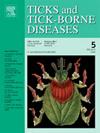Quantitative detection of Theileria haneyi in South African horses
IF 3.4
2区 医学
Q2 INFECTIOUS DISEASES
引用次数: 0
Abstract
Theileria haneyi is an apicomplexan parasite closely related to Theileria equi, a known causative agent of equine piroplasmosis. The molecular distinction between these parasites relies on a nested polymerase chain reaction (PCR) assay, which has been reported to be unreliable. A recently reported indirect ELISA based on equi merozoite antigen 11 (Thema-11) of T. haneyi can detect geographically diverse T. haneyi strains. Since the ema-11 gene is exclusive to T. haneyi, it was chosen as the target for developing a TaqMan minor groove binder (MGB™) quantitative real-time PCR (qPCR). Published T. haneyi ema-11 gene sequences were used to design primers to amplify the ema-11 gene, and ema-11 amplicons from South African samples were cloned and sequenced. An alignment of the South African ema-11 gene sequences with published T. haneyi ema-11 gene sequences enabled the identification of a conserved region for the design of the qPCR assay. The T. haneyi ema-11 (Thema-11) qPCR assay was efficient, specific, and sensitive in detecting T. haneyi ema-11. The detection limit was determined to be 1.169 × 10–3 % parasitized erythrocytes. The performance of the Thema-11 qPCR assay was evaluated together with a T. equi ema-1-specific qPCR assay. Theileria haneyi was detected in 67.6 % of the South African field samples screened, while the occurrence of T. equi based on the quantitative amplification of the ema-1 gene was higher (91.8 %). Our results suggest that combined, the Thema-11 and T. equi ema-1 qPCR assays could detect and differentiate between T. haneyi and T. equi infections.

南非马中黑氏芽孢杆菌的定量检测
哈尼伊勒菌是一种顶端复合体寄生虫,与马勒菌密切相关,马勒菌是已知的马螺旋体病病原体。这些寄生虫之间的分子区分依赖于巢式聚合酶链反应(PCR)测定,据报道这是不可靠的。最近报道的一种基于哈尼伊T. merozoite抗原11 (therma -11)的间接酶联免疫吸附试验可以检测不同地理位置的哈尼伊T.菌株。由于ma-11基因是T. haneyi独有的,因此选择它作为开发TaqMan次要凹槽结合物(MGB™)定量实时PCR (qPCR)的目标。利用已发表的T. haneyi ema-11基因序列设计引物扩增ema-11基因,并对来自南非样本的ema-11扩增子进行克隆和测序。将南非的ema-11基因序列与已发表的T. haneyi ema-11基因序列比对,可以确定一个保守区域,用于设计qPCR检测。哈尼伊T. ma-11 (Thema-11) qPCR检测哈尼伊T. ma-11高效、特异、敏感。检出限为1.169 × 10 - 3%。将Thema-11 qPCR检测的性能与T. equi ma-1特异性qPCR检测一起进行评估。在南非筛选的田间样本中检出了67.6%的哈尼氏滴虫,而基于ema-1基因定量扩增的equi滴虫的检出率更高(91.8%)。我们的结果表明,theta -11和T. equi ma-1 qPCR联合检测可以检测和区分T. haneyi和T. equi感染。
本文章由计算机程序翻译,如有差异,请以英文原文为准。
求助全文
约1分钟内获得全文
求助全文
来源期刊

Ticks and Tick-borne Diseases
INFECTIOUS DISEASES-MICROBIOLOGY
CiteScore
6.90
自引率
12.50%
发文量
185
审稿时长
6-12 weeks
期刊介绍:
Ticks and Tick-borne Diseases is an international, peer-reviewed scientific journal. It publishes original research papers, short communications, state-of-the-art mini-reviews, letters to the editor, clinical-case studies, announcements of pertinent international meetings, and editorials.
The journal covers a broad spectrum and brings together various disciplines, for example, zoology, microbiology, molecular biology, genetics, mathematical modelling, veterinary and human medicine. Multidisciplinary approaches and the use of conventional and novel methods/methodologies (in the field and in the laboratory) are crucial for deeper understanding of the natural processes and human behaviour/activities that result in human or animal diseases and in economic effects of ticks and tick-borne pathogens. Such understanding is essential for management of tick populations and tick-borne diseases in an effective and environmentally acceptable manner.
 求助内容:
求助内容: 应助结果提醒方式:
应助结果提醒方式:


